News for our work “Stochastic spin-orbit-torque device as the STDP synapse for spiking neural networks”, recently published in SCPMA
研究论文 | 基于随机自旋轨道矩器件构建人工脉冲神经网络硬件


创新要点:
本文利用自旋轨道矩器件中电流驱动存储层磁矩随机翻转和其温度特性实现了人工突触。由于存储层磁矩的随机翻转概率随输入脉冲电流及其时间间隔变化,其构建的人工突触的可塑性可以由存储层磁矩方向对应的霍尔电阻变化实现。基于该类自旋人工突触,研究人员构建了两种脉冲神经网络硬件原型,实现了非监督的手写数字识别和逻辑运算学习。
原文信息:
H. Li, L. Li, K. Zhou, C. Yan, Z. Gao, Z. Li, and R. Liu, Stochastic spin-orbit-torque device as the STDP synapse for spiking neural networks, Sci. China-Phys. Mech. Astron. 66, 257512 (2023), https://doi.org/10.1007/s11433-022-2081-5
News for our work about magnetic dynamics in a chiral helimagnet MnNb3S6, recently published in SCPMA
研究论文 | 手性螺旋磁体MnNb3S6中拓扑自旋结构的动力学表征
《中国科学:物理学 力学 天文学》英文版(SCIENCE CHINA Physics, Mechanics & Astronomy, SCPMA)出版南京大学刘荣华、陈丽娜和中国科学院合肥物质科学研究院张蕾团队合作成果,文章题为“Temperature- and field angular-dependent helical spin period characterized by magnetic dynamics in a chiral helimagnet MnNb3S6”,于2023年第66卷第1期刊出。
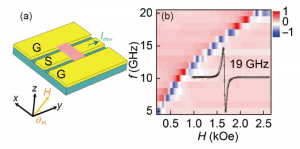
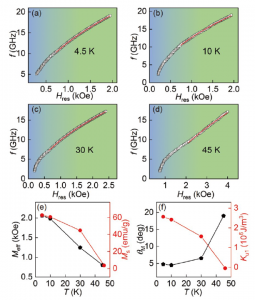
本文利用宽频微分铁磁共振技术研究了单轴手性磁性单晶体MnNb3S6中几类特殊自旋结构的磁动力学特性。在高场铁磁态下,其振荡频率与共振磁场的色散曲线很好地符合单一铁磁态下标准基特尔磁动力学模型。对于低磁场手性磁孤子晶格态偏离标准基特尔模型,本文基于螺旋自旋序和铁磁序混合构型,提出了一类修正的基特尔自旋动力学模型。该修正模型能很好地拟合实验获得的磁动力学中自旋共振磁场与磁场角度的依赖关系。此外,通过拟合这类自旋共振行为随温度和磁场角度的变化关系,还能获得MnNb3S6中拓扑自旋序的占比以及螺旋周期L(H)/L(0)随磁场变化的依赖关系,而不需要精细复杂的洛伦兹显微成像技术的辅助。因此,本文方法适用于大多数磁学实验室研究这类拓扑手性磁体的非平庸自旋结构以及相应的自旋动力学。
创新要点:
为解决目前MnNb3S6中螺旋自旋周期仍未被表征的难题,本文基于螺旋自旋序和铁磁序的混合构型,提出了一类修正的基特尔自旋动力学模型。该修正模型能很好地拟合实验获得的磁动力学中自旋共振磁场与磁场角度的依赖关系。通过该自旋动力学方法,本文不仅能够提取螺旋磁体的螺旋周期信息,还能获得其螺旋周期随温度和外加磁场大小、角度的依赖关系相图。本文研究结果将有助于研究人员利用自旋动力学手段来探索非平庸拓扑螺旋磁体中的新奇物理效应及其在自旋电子器件方面的应用。
Dissertation defense
- Mr. Zhengyu Gao attended the mid-term examination on Ph.D.
- Mr. Zui Tao attended the mid-term examination on Master degree.
Temperature- and field angular-dependent helixcal spin period characterized by magnetic dynamics in a chiral helimagnet MnNb3S6
Our new work entitled “Temperature- and field angular-dependent helixcal spin period characterized by magnetic dynamics in a chiral helimagnet MnNb3S6” is published in Sci. China-Phys. [Sci. China-Phys. Mech. Astron. 66, 217511 (2023)]. In this work, we perform the systematic ferromagnetic resonance experiment to investigate thoroughly the detailed dependence of magnetic dynamics corresponding to the nontrivial CSL in MnNb3S6 on the field magnitude, angle, and temperature. We find that chiral helimagnet MnNb3S6 exhibits a distinct field angular dependence of spin resonance in lowfield nontrivial CSL from the uniform FMR in high-field FFM. Then, we propose a modified Kittel model considering partial helix spin textures, which can successfully describe the experimentally observed spin dynamics of the low-field nontrivial CSL at different temperatures. Moreover, the modified Kittel model also enables us to extract temperature and field-dependent proportion of the helical spin texture and helical spin period ratio L(H)/L(0), like the sophisticated Lorentz micrograph technique used in most chiral helimagnets. The demonstrated method can generally be used as an alternative and easy-access approach to explore interesting magnetic dynamics not just in MnNb3S6 and other topologically nontrivial chiral magnets.
Current-driven magnetization dynamics and its correlation with magnetization configurations in perpendicularly magnetized tunnel junctions
Our new work entitled “Current-driven magnetization dynamics and its correlation with magnetization configurations in perpendicularly magnetized tunnel junctions” is published in J. Appl. Phys. [J. Appl. Phys. 132, 173906 (2022)]. In this work, we study spin-transfer-torque-driven magnetization dynamics of a perpendicular magnetic tunnel junction nanopillar. Through the combined investigations on spin-torque ferromagnetic resonance and microwave spectroscopy, it is found that the free layer (FL) and the weak pinned reference layer (RL) exhibit distinct dynamic behaviors. First, frequency vs field dispersion for the FL and RL shows an opposite trend as the field varies. Second, the FL can support a single spin-wave (SW) mode for both parallel and antiparallel configurations, while the RL exhibits spin-wave excitation only for the antiparallel state. Those two SW modes coexist at the antiparallel state, and their oscillation frequency exhibits a crossover phenomenon with increasing the external magnetic field, which could be helpful in the mutual synchronization of auto-oscillations for SW-based neuromorphic computing.
Magnetic dynamics of two-dimensional itinerant ferromagnet Fe3GeTe2
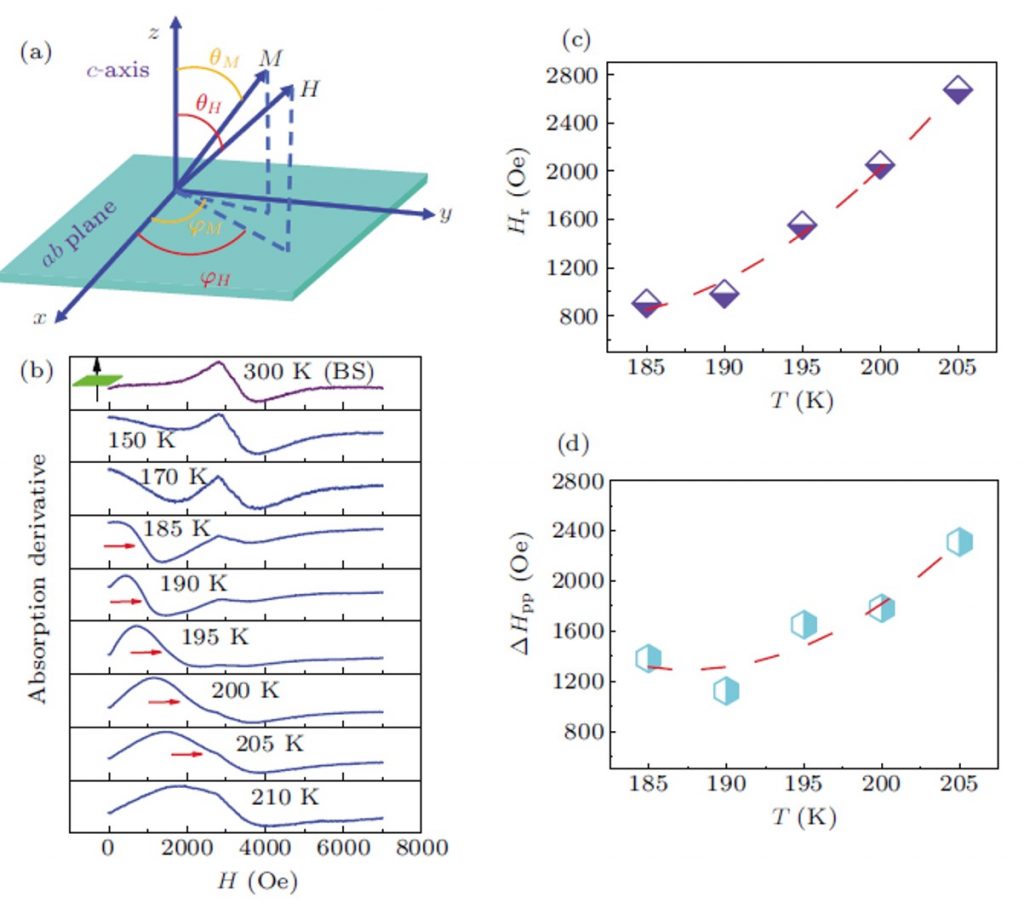 Among the layered two-dimensional ferromagnetic materials (2D FMs), due to a relatively high TC, the van der Waals (vdW) Fe3GeTe2 (FGT) crystal is of great importance for investigating its distinct magnetic properties. Recent, in collaboration with Prof Yongbing Xu’s group in School of Electronic Science and Engineering, Nanjing University, we published a work entitled “Magnetic dynamics of two-dimensional itinerant ferromagnet Fe3GeTe2” in Chin. Phys. B [Chin. Phys. B 30(9), 097501(2021)]. Congratulations to Ms. Lijun Ni. In this work, Here, we have carried out static and dynamic magnetization measurements of the FGT crystal with a Curie temperature Tc = 204 K.The M–H hysteresis loops with in-plane and out-of-plane orientations show that FGT has a strong perpendicular magnetic anisotropy with the easy axis along its c-axis. Moreover, we have calculated the uniaxial magnetic anisotropy constant (K1) from the SQUID measurements. The dynamic magnetic properties of FGT have been probed by utilizing the high sensitivity electron-spin-resonance (ESR) spectrometer at cryogenic temperatures. Based on an approximation of single magnetic domain mode, the K1 and the effective damping constant have also been determined from the out-of-plane angular dependence of ferromagnetic resonance (FMR) spectra obtained at the temperature range of 185 K to TC. We have found large magnetic damping with the effective damping constant ~ 0.58 along with a broad linewidth (delta H_pp > 1000 Oe at 9.48 GHz, H// c-axis). Our results provide useful dynamics information for the development of FGT-based spintronic devices.
Among the layered two-dimensional ferromagnetic materials (2D FMs), due to a relatively high TC, the van der Waals (vdW) Fe3GeTe2 (FGT) crystal is of great importance for investigating its distinct magnetic properties. Recent, in collaboration with Prof Yongbing Xu’s group in School of Electronic Science and Engineering, Nanjing University, we published a work entitled “Magnetic dynamics of two-dimensional itinerant ferromagnet Fe3GeTe2” in Chin. Phys. B [Chin. Phys. B 30(9), 097501(2021)]. Congratulations to Ms. Lijun Ni. In this work, Here, we have carried out static and dynamic magnetization measurements of the FGT crystal with a Curie temperature Tc = 204 K.The M–H hysteresis loops with in-plane and out-of-plane orientations show that FGT has a strong perpendicular magnetic anisotropy with the easy axis along its c-axis. Moreover, we have calculated the uniaxial magnetic anisotropy constant (K1) from the SQUID measurements. The dynamic magnetic properties of FGT have been probed by utilizing the high sensitivity electron-spin-resonance (ESR) spectrometer at cryogenic temperatures. Based on an approximation of single magnetic domain mode, the K1 and the effective damping constant have also been determined from the out-of-plane angular dependence of ferromagnetic resonance (FMR) spectra obtained at the temperature range of 185 K to TC. We have found large magnetic damping with the effective damping constant ~ 0.58 along with a broad linewidth (delta H_pp > 1000 Oe at 9.48 GHz, H// c-axis). Our results provide useful dynamics information for the development of FGT-based spintronic devices.
Temperature and electric field effects on the dynamic modes in a spin current auto-oscillator
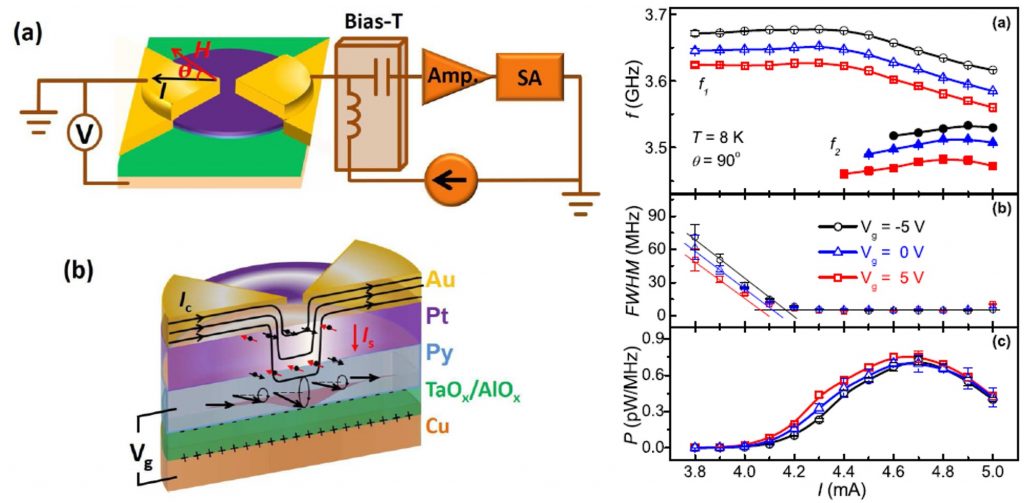 Our new work entitled ”Temperature and electric field effects on dynamic modes in spin current auto-oscillator”is published in Phys. Rev. B. [Phys. Rev. B 103, 144426(2021)]. In this work, we systematically study spectral characteristics of emission microwave signal by a spin current nano-oscillator (SCNO) based on TaOx/Py(3)/Pt(2) trilayers as a function of current, in-plane magnetic field angle, electrostatic gating, and temperature. The current dependence of spectral characteristics shows that such SCNO exhibits a single coherent oscillation mode at low currents, and then transfers into a multimode coexistence regime with several oscillation peaks, related to spatially separated oscillation regions, at high currents. The linewidth of these modes shows an exponential temperature dependence, indicating thermally activated mode transitions or mode hopping behavior among these spatially separated oscillation regions due to the mode coupling caused by strong thermal-magnon-mediated scattering rate at high temperatures. Additionally, electrostatic gating on oscillation frequency shows a temperature-independent behavior, but gets enhanced in the strongly nonlinear oscillation regime. The enhanced phenomenon is caused by a combination of nonlinear frequency redshift and driving current shift due to electric-field modulation of current-induced spin-orbit torques. The demonstrated electric-field and current control of three-terminal SCNO provides an efficient approach to developing electrically tunable microwave generators in radio frequency integrated circuits and spin-wave-based logic gates in magnonic devices.
Our new work entitled ”Temperature and electric field effects on dynamic modes in spin current auto-oscillator”is published in Phys. Rev. B. [Phys. Rev. B 103, 144426(2021)]. In this work, we systematically study spectral characteristics of emission microwave signal by a spin current nano-oscillator (SCNO) based on TaOx/Py(3)/Pt(2) trilayers as a function of current, in-plane magnetic field angle, electrostatic gating, and temperature. The current dependence of spectral characteristics shows that such SCNO exhibits a single coherent oscillation mode at low currents, and then transfers into a multimode coexistence regime with several oscillation peaks, related to spatially separated oscillation regions, at high currents. The linewidth of these modes shows an exponential temperature dependence, indicating thermally activated mode transitions or mode hopping behavior among these spatially separated oscillation regions due to the mode coupling caused by strong thermal-magnon-mediated scattering rate at high temperatures. Additionally, electrostatic gating on oscillation frequency shows a temperature-independent behavior, but gets enhanced in the strongly nonlinear oscillation regime. The enhanced phenomenon is caused by a combination of nonlinear frequency redshift and driving current shift due to electric-field modulation of current-induced spin-orbit torques. The demonstrated electric-field and current control of three-terminal SCNO provides an efficient approach to developing electrically tunable microwave generators in radio frequency integrated circuits and spin-wave-based logic gates in magnonic devices.
Controllable excitation of multiple spin wave bullet modes in a spin Hall nano-oscillator based on [Ni/Co]/Pt multilayers
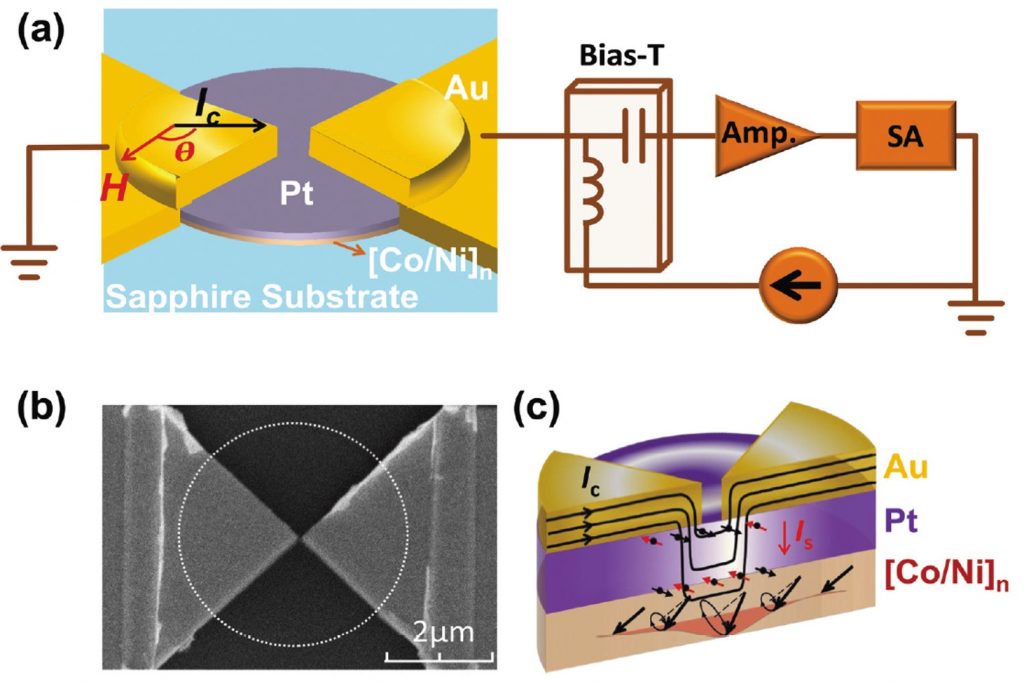 Spin-torque nano-oscillators are promising candidates for many radio frequency and magnon-based nanodevices due to their broad frequency tunability, easy fabrication and high durability. Our new work entitled ”Controllable excitation of multiple spin wave bullet modes in a spin Hall nano-oscillator based on [Ni/Co]/Pt multilayers” is published in Nanoscale [Nanoscale, 13, 7838-7843(2021)]. To explore the tunability, in this work, we chose a [Ni/Co]/Pt-based spin Hall nano-oscillator with a moderate uniaxial anisotropy to systematically study the corresponding magnetodynamics excited by locally injecting a dc current into a nanoscale region of the extended multilayers [Ni/Co]/Pt under certain conditions. We find that the excitation current, the magnitude and orientation of magnetic field, and temperature can be used as a tool to selectively excite certain frequency bullet modes. The transition between nonlinear self-localized bullet modes with different frequencies is caused by the experimental parameter-induced change of energy landscape because, in the [Ni/Co]/Pt system, the strong spatial fluctuation of interfacial magnetic anisotropy leads to the variations of the internal magnetic field of the actual device. Our results demonstrate that the fluctuations of magnetic properties can promote experimental control of spin-torque driven magnetization dynamics in spin Hall nano-oscillators, and the application of expediting nonlinear magnetization oscillators in magnon-based devices and neuromorphic computing.
Spin-torque nano-oscillators are promising candidates for many radio frequency and magnon-based nanodevices due to their broad frequency tunability, easy fabrication and high durability. Our new work entitled ”Controllable excitation of multiple spin wave bullet modes in a spin Hall nano-oscillator based on [Ni/Co]/Pt multilayers” is published in Nanoscale [Nanoscale, 13, 7838-7843(2021)]. To explore the tunability, in this work, we chose a [Ni/Co]/Pt-based spin Hall nano-oscillator with a moderate uniaxial anisotropy to systematically study the corresponding magnetodynamics excited by locally injecting a dc current into a nanoscale region of the extended multilayers [Ni/Co]/Pt under certain conditions. We find that the excitation current, the magnitude and orientation of magnetic field, and temperature can be used as a tool to selectively excite certain frequency bullet modes. The transition between nonlinear self-localized bullet modes with different frequencies is caused by the experimental parameter-induced change of energy landscape because, in the [Ni/Co]/Pt system, the strong spatial fluctuation of interfacial magnetic anisotropy leads to the variations of the internal magnetic field of the actual device. Our results demonstrate that the fluctuations of magnetic properties can promote experimental control of spin-torque driven magnetization dynamics in spin Hall nano-oscillators, and the application of expediting nonlinear magnetization oscillators in magnon-based devices and neuromorphic computing.
Collimated Bidirectional Propagating Spin Wave Generated by a Nonlocal Spin-Current Nano-oscillator
Pure spin currents,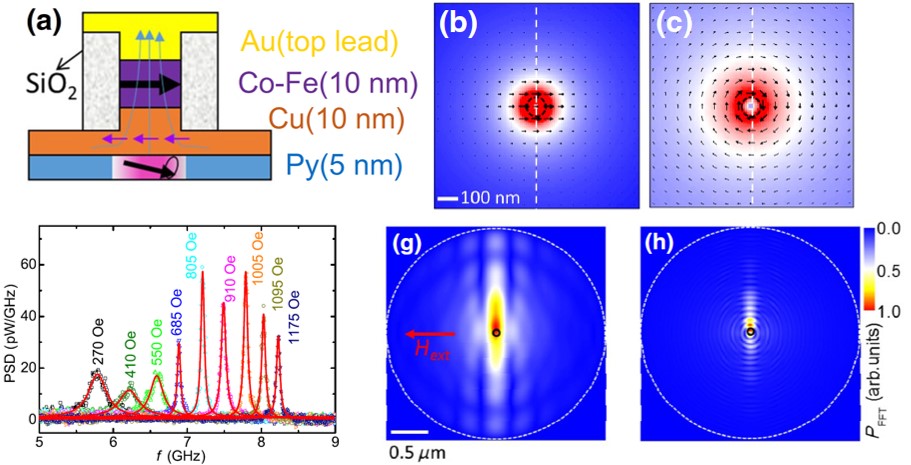 generated by nonlocal spin injection and spin-orbit effects, have been widely used to control magnetization reversal and dynamics by current without charge transfer and its side effects in the device’s actual working region. Our new work entitled”Collimated Bidirectional Propagating Spin Wave Generated by a Nonlocal Spin-Current Nano-oscillator” is published in Phys. Rev. Applied [Phys. Rev. Applied 16, 034044(2021)]. Congratulations to Dr. Lina Chen and Mr. Zhenyu Gao. In this work, we experimentally demonstrate that a single coherent spin-wave mode can be excited by the pure spin current in a nonlocal spin-injection spin-valve device. The microwave spectra show that the observed spin-wave frequency is higher than the ferromagnetic resonance frequency, and almost does not change with the excitation current at moderate magnetic fields, indicating that the observed dynamical mode is a linear propagating spin-wave mode. Furthermore, micromagnetic simulations based on our device geometry generally reproduce the experimentally observed field-dependent and current-dependent oscillation characteristics, and provide us with the additional spatial information that the spin-wave mode exhibits collimated and bidirectional propagation paths in the direction perpendicular to the applied magnetic field. Our simulation results also show that the current local Oersted field in our nonlocal device is much smaller than in conventional nanocontact magnetic oscillators, and has a minimal impact on the spin-wave dynamics. A near-symmetrically-collimated and bidirectional propagating spin-wave beam with magnetic field–controllable beam direction and current-dependent frequency, achieved in our demonstrated nonlocal spin-current nano-oscillator, can be used as a local spin-wave source for magnonic logic devices and can be used to build daisy-chaining oscillatory neural networks with mutual synchronization.
generated by nonlocal spin injection and spin-orbit effects, have been widely used to control magnetization reversal and dynamics by current without charge transfer and its side effects in the device’s actual working region. Our new work entitled”Collimated Bidirectional Propagating Spin Wave Generated by a Nonlocal Spin-Current Nano-oscillator” is published in Phys. Rev. Applied [Phys. Rev. Applied 16, 034044(2021)]. Congratulations to Dr. Lina Chen and Mr. Zhenyu Gao. In this work, we experimentally demonstrate that a single coherent spin-wave mode can be excited by the pure spin current in a nonlocal spin-injection spin-valve device. The microwave spectra show that the observed spin-wave frequency is higher than the ferromagnetic resonance frequency, and almost does not change with the excitation current at moderate magnetic fields, indicating that the observed dynamical mode is a linear propagating spin-wave mode. Furthermore, micromagnetic simulations based on our device geometry generally reproduce the experimentally observed field-dependent and current-dependent oscillation characteristics, and provide us with the additional spatial information that the spin-wave mode exhibits collimated and bidirectional propagation paths in the direction perpendicular to the applied magnetic field. Our simulation results also show that the current local Oersted field in our nonlocal device is much smaller than in conventional nanocontact magnetic oscillators, and has a minimal impact on the spin-wave dynamics. A near-symmetrically-collimated and bidirectional propagating spin-wave beam with magnetic field–controllable beam direction and current-dependent frequency, achieved in our demonstrated nonlocal spin-current nano-oscillator, can be used as a local spin-wave source for magnonic logic devices and can be used to build daisy-chaining oscillatory neural networks with mutual synchronization.
Mode Structures and Damping of Quantized Spin Waves in Ferromagnetic Nanowires
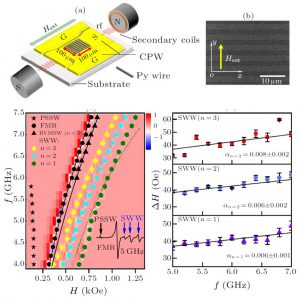 Magnonic devices based on spin waves are considered as a new generation of energy-efficient and high-speed devices for storage and processing of information. Our new work entitled “Mode Structures and Damping of Quantized Spin Waves in Ferromagnetic Nanowires” is published in Chinese Physical Letter [Qingwei Fu1, Yong Li2, Lina Chen1, Fusheng Ma2, Haotian Li1, Yongbing Xu3,4, Bo Liu5, Ronghua Liu1*, Chin. Phys. Lett. 37, 087503(2020)]. Congratulations to Mr. Qingwei Fu. In this work, we experimentally demonstrate that three distinct dominated magneto-dynamic modes are excited simultaneously and coexist in a transversely magnetized ferromagnetc wire by combining our home-made CPW broadband FMR spectroscopy and electron beam lithography technique. Besides the uniform FMR mode, the spin-wave well mode, the backward volume magnetostatic spin-wave mode, and the perpendicular standing spin-wave mode are experimentally observed and further confirmed with more detailed spatial profiles by micromagnetic simulation. Furthermore, our experimental approach can also access and reveal damping coefficients of these spin-wave modes. Our results make further insight into the complexity of the dynamical magnetization states in microscale confined FWs, which offers valuable information regarding the excitation of spin waves for the development of magnonic devices. This work is collaborated with Prof. Fusheng Ma’s group, School of Physics and Technology, Nanjing Normal University; Prof. Yongbing Xu in School of Electronic Science and Engineering, Nanjing University, and Dr. Bo Liu in Key Laboratory of Spintronics Materials, Devices and Systems of Zhejiang Province. We especially want to thank Prof. Fusheng Ma and Mr. Yong Li for providing their support in micromagnetic simulation.
Magnonic devices based on spin waves are considered as a new generation of energy-efficient and high-speed devices for storage and processing of information. Our new work entitled “Mode Structures and Damping of Quantized Spin Waves in Ferromagnetic Nanowires” is published in Chinese Physical Letter [Qingwei Fu1, Yong Li2, Lina Chen1, Fusheng Ma2, Haotian Li1, Yongbing Xu3,4, Bo Liu5, Ronghua Liu1*, Chin. Phys. Lett. 37, 087503(2020)]. Congratulations to Mr. Qingwei Fu. In this work, we experimentally demonstrate that three distinct dominated magneto-dynamic modes are excited simultaneously and coexist in a transversely magnetized ferromagnetc wire by combining our home-made CPW broadband FMR spectroscopy and electron beam lithography technique. Besides the uniform FMR mode, the spin-wave well mode, the backward volume magnetostatic spin-wave mode, and the perpendicular standing spin-wave mode are experimentally observed and further confirmed with more detailed spatial profiles by micromagnetic simulation. Furthermore, our experimental approach can also access and reveal damping coefficients of these spin-wave modes. Our results make further insight into the complexity of the dynamical magnetization states in microscale confined FWs, which offers valuable information regarding the excitation of spin waves for the development of magnonic devices. This work is collaborated with Prof. Fusheng Ma’s group, School of Physics and Technology, Nanjing Normal University; Prof. Yongbing Xu in School of Electronic Science and Engineering, Nanjing University, and Dr. Bo Liu in Key Laboratory of Spintronics Materials, Devices and Systems of Zhejiang Province. We especially want to thank Prof. Fusheng Ma and Mr. Yong Li for providing their support in micromagnetic simulation.
近期评论